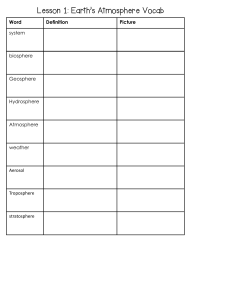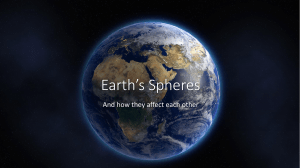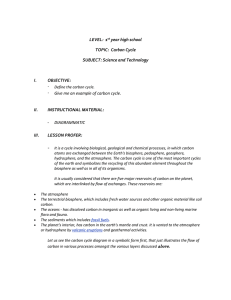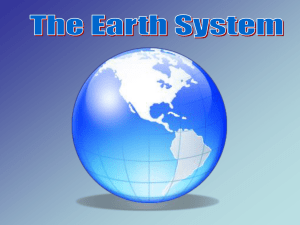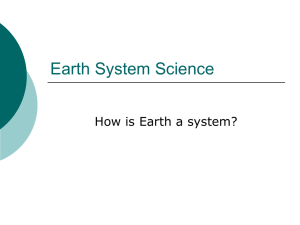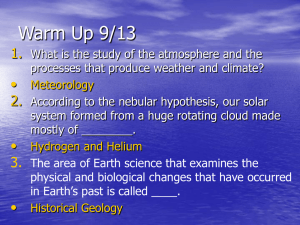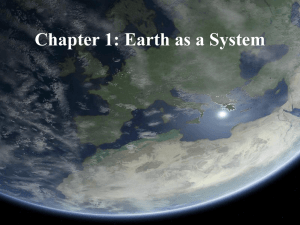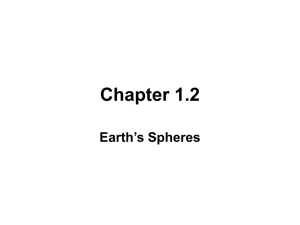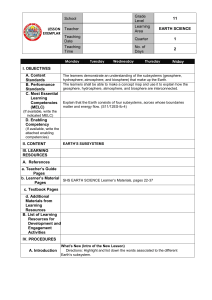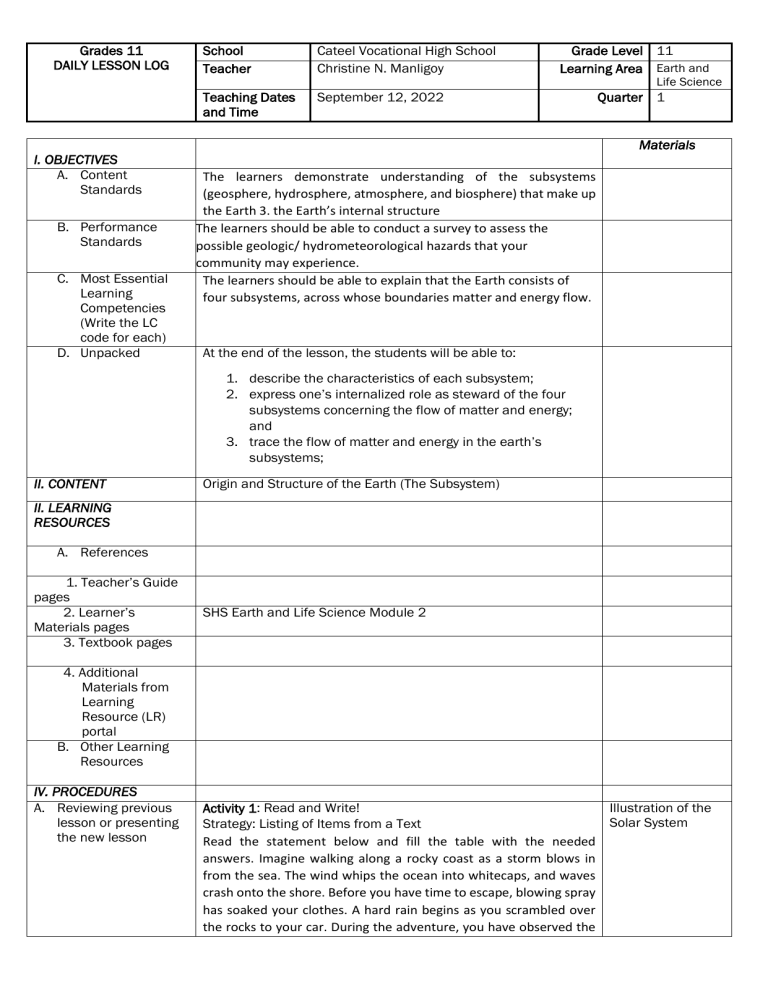
Grades 11 DAILY LESSON LOG School Teacher Cateel Vocational High School Christine N. Manligoy Teaching Dates and Time September 12, 2022 Grade Level 11 Learning Area Earth and Life Science Quarter 1 Materials I. OBJECTIVES A. Content Standards B. Performance Standards C. Most Essential Learning Competencies (Write the LC code for each) D. Unpacked The learners demonstrate understanding of the subsystems (geosphere, hydrosphere, atmosphere, and biosphere) that make up the Earth 3. the Earth’s internal structure The learners should be able to conduct a survey to assess the possible geologic/ hydrometeorological hazards that your community may experience. The learners should be able to explain that the Earth consists of four subsystems, across whose boundaries matter and energy flow. At the end of the lesson, the students will be able to: 1. describe the characteristics of each subsystem; 2. express one’s internalized role as steward of the four subsystems concerning the flow of matter and energy; and 3. trace the flow of matter and energy in the earth’s subsystems; II. CONTENT Origin and Structure of the Earth (The Subsystem) II. LEARNING RESOURCES A. References 1. Teacher’s Guide pages 2. Learner’s Materials pages 3. Textbook pages SHS Earth and Life Science Module 2 4. Additional Materials from Learning Resource (LR) portal B. Other Learning Resources IV. PROCEDURES A. Reviewing previous lesson or presenting the new lesson Illustration of the Activity 1: Read and Write! Solar System Strategy: Listing of Items from a Text Read the statement below and fill the table with the needed answers. Imagine walking along a rocky coast as a storm blows in from the sea. The wind whips the ocean into whitecaps, and waves crash onto the shore. Before you have time to escape, blowing spray has soaked your clothes. A hard rain begins as you scrambled over the rocks to your car. During the adventure, you have observed the spheres of the Earth. List down the terms that are used in the statement that reflects to what made up the Earth. Categorize them based on the following: Air Water Land With Life B. Establishing a purpose for the lesson/Motivation/M otive Questions C. Presenting examples/instances of the new lesson Activity 1: What’s in the Picture? Strategy: Picture Analysis D. Discussing new concepts and practicing new skills #1 (Explore) E. Discussing new concepts and practicing new skills #2 (Explore)) F. Developing mastery (leads to Formative Assessment 3) (Explanation) Activity 3: We are Connected! Strategy: Diagram Analysis Procedure: According to John Muir, “When one tugs at a single thing in nature, he finds it attached to the rest of the world.” How is the given diagram related to the said quote? How does the four subsystems of the Earth connect with each other? Write your answer on a separate sheet of paper G. Finding practical applications of concepts and skills in daily living (Elaborate) Analyze and label the given picture. From the picture, create a general concept on each picture and identify the physical characteristics of the subsystem of the Earth. Differentiate one with the other. Write your answers on a separate sheet of paper Activity 6: My Environmental ‘To Do List” Strategy: Tabulation Picture of Earth The human population has increased rapidly since the 1700’s. For most of human history, there were fewer than half-billion people on Earth. In mid- 2009, 6.7 billion people inhabited our planet. Because of these, extensive pollution is everywhere. As a student, what can you do to save not only a particular system, but the Earth itself? Tabulate your answer on a separate sheet of paper . Copy the template below. My Environmental To Do List H. Making generalizations and abstractions about the lesson GENERALIZATION Activity 7: LET’S SUM IT UP! Strategy: Question-Answer Direction: How are each of the four subsystems connected with each other? I. Multiple Choice. Choose the letter of the best answer. Write the chosen letter on a separate sheet of paper. 1. Earth includes beach grasses, forms of life in the sea, on land, and even in the air. Which term best describes the statement? A. atmosphere B. biosphere C. geosphere D. hydrosphere 2. Which system of the Earth is considered as the largest component of the Earth? A. atmosphere B. biosphere C. geosphere D. hydrosphere 3. Life is supported by oxygen and carbon dioxide. Which subsystem will best describe the statement? A. atmosphere B. biosphere C. geosphere D. hydrosphere 4. Relationship between the complex communities of individual organism is seen in the different systems of the Earth. What do you call the unit in nature? A. ecosystem B. complexity C. ground D. system 5. All of earth’s cycles and spheres are interconnected. Why is this so? A. because they are interconnected B. because Earth is where we live in C. because Earth is the only living planet D. because every organism has its own function in the Earth Evaluating learning J. Additional activities for application or remediation (Extension) V. REMARKS VI. REFLECTION 6. What is an example of a connection between atmosphere and geosphere? A. water B. nitrogen C. mountains D. volcanic eruption release gas 7. Which among the choices is an example of a connection between atmosphere and hydrosphere? A. lakes B. rain C. rivers D. rocks 8. From the given choices, which is an example of a connection between biosphere connecting to atmosphere? A. Animals eat plants. B. Animals drink water. C. Animals lie in caves. D. Plants produce oxygen. 9. Among the choices, which clearly gives an example of connection between hydrosphere and geosphere? A. boats transporting goods B. fish swimming in water C. water evaporating to make clouds D. waves eroding rocks on beach 10. All living things, including land and sea made up the Earth. Which term best described the statement? A. geosphere B. ozone layer C. atmosphere D. biosphere EXTEND Activity 7: “Connect Me Spheres” Strategy: Procedure: Analyze the interactions of the spheres after the onslaught of Taal Volcano. Answer the questions that follow. Use a separate sheet of paper for your answers. A. No. of learners who earned 80% in the evaluation B. No. of learners who require additional activities for remediation C. Did the remedial lessons work? No. of learners who have caught up with the lesson D. No. of learners who continue to require remediation E. Which of my teaching strategies worked well? Why did these work? F. What difficulties did I encounter which my principal or supervisor can help me solve? G. What innovation or localized materials did I use/discover which I wish to share with other teachers? PREPARED & SUBMITTED BY: CHECKED BY: CHRISTINE N. MANLIGOY, MT-1 Subject Teacher DR. CHRYZA ARSENIA D. REYES Principal IV

